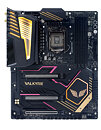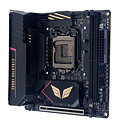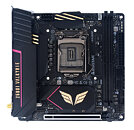Tuesday, January 19th 2021

BIOSTAR Announces the Z590 Valkyrie and Z590I Valkyrie Flagship Motherboards
BIOSTAR, a leading manufacturer of motherboards, graphics cards, and storage devices today announces the launch of their latest Z590 VALKYRIE series motherboard range engineered to run Intel's 11th Gen Rocket Lake-S processors.
Designed based on the latest Z590 chipset from Intel, BIOSTAR's VALKYRIE series motherboards are a brand-new breed of enthusiast grade motherboards in the market. Launched in two versions with two different form factors, the Z590 VALKYRIE (ATX) and the Z590I VALKYRIE (Mini-ITX) both carries a fully armored cover design resonating with BIOSTAR's goal of producing a premium flagship motherboard range that adds form, functionality and the wow factor to their product range.An all-new armor gear design brings sleek design elements with passive cooling capability to the mix, and the use of gold and pink accents showcases a powerful yet royal outlook making the new VALKYRIE motherboard range fresh and extremely swoon worthy. Features like BIOSTAR's proprietary LED ROCK ZONE and VIVID LED DJ which are fan favorites when it comes to RGB lighting technology adds extra customization to the mix for users.
Engineered by BIOSTAR with the latest and greatest motherboard technology in the planet, the Z590 VALKYRIE series motherboards are ideal for users looking to install the best hardware into their new gaming rig or editing system.
With features like PCIe 4.0 which is 2x times faster than the older PCIe 3.0 and supports a bandwidth of 16GT/s bit rate, the Z590 VALKYRIE stands above its competitors by both style and technology.
Capable of running up to 128 GB of DDR4 Memory on 4 DIMMs with boost clock speeds that can reach up to 5000+(OC), the VALKYRIE series is designed for all purposes, easily capable of handling the best hardware in the toughest use cases.
The VALKYRIE series motherboards are powered by BIOSTAR's 22 phase power design and Digital PWM technology which increases system efficiency and has faster transient performance. Smartly integrated 20K Hours Durable Solid Capacitors adds an extra layer of protection to the system with its durability while providing a stable voltage output with unhindered performance.
Features like Dr. Mos help users to set up smooth overclock performance while BIOSTAR's proprietary Tough Power Connectors ensure the stability and reliability of the power supply.
Furthermore, the VALKYRIE series motherboards are engineered with fins heat sink combined together with active cooling and a full copper base and metal back plate design which can improve power supply efficiency, reduce overall temperature by 29.1% and extend the life and quality of your computer.
Storage wise, the VALKYRIE series utilizes superior PCIe M.2 4.0 technology which provides a bandwidth of 64 Gb/s and is 2x times faster than PCIe M.2 3.0 under lower latency. Additional features like CPU OPT Header, A.I FAN and BIOS EZ Mode provides the VALKYRIE series motherboard, added dexterity and ease of use for quick installations and system management.
When it comes to rear I/O, the Z590 VALKYRIE motherboard has a fully packed Rear I/O panel protected by its Armor Gear shield with ports like 1x PS/2 Keyboard/ Mouse port for older devices.
The motherboard also comes with a single USB 3.2 (Gen2x2) Type-C port which has a max data transfer rate of 20 Gbps and improved data transmission speed, 5x USB 3.2 (Gen2) ports, and 2x USB 3.2 (Gen1) ports are present for fast efficient connectivity.
2x WIFI Antenna ports and the capability to run WiFi 6 is readily available for faster internet connection and a single LAN port powered by Realtek RTL8125B chipset brings up the rest for network connectivity with BIOSTAR's 2.5 Guard technology providing safe stable internet connection with protection against electrical surges and prevents damage from lightning strikes. For display connectivity, the Z590 VALKYRIE motherboard comes with a built-in DP port (DP1.4) capable of supporting up to 5K screen resolution with the power of the latest Intel 11th Gen processors, delivering bright, crystal-clear images.
Audio Codec ALC1220 is the preferred audio technology used by the Z590 VALKYRIE motherboard with 5x Audio connectors capable of delivering 7.1 Channels, High-Definition Audio for smooth user experience for gaming and watching movies with high quality surround sound. Furthermore, the Z590 VALKYRIE motherboard also comes with a single SPDIF_Out port for that added audio amplification.
The Z590I VALKYRIE motherboard also comes with a highly versatile I/O palette. Providing much more than its small form, the Mini ITX variant of the VALKYRIE series is packed with all the essentials including 1x USB 3.2 (Gen2x2) Type C port, 2x USB 3.2 (Gen2) ports, 3x USB 3.2 (Gen1) ports and 2x USB 2.0 ports to provide ample USB connectivity. Features like a traditional PS/2 Keyboard/ Mouse port provides users with more flexibility when connecting their input devices. A single display type port is available for Video output together with an HDMI 4K2K port that can emulate bright, crystal-clear images at a 4K resolution on a refresh rate of 60Hz, this is achieved by the power of the latest Intel processors.
Much like its bigger sibling, the Z590I VALKYRIE motherboard uses Realtek RTL8125B chipset for its single port LAN connectivity with BIOSTAR's proprietary 2.5 Guard technology to protect the system against any unwanted electrical hazards. Two WIFI Antenna ports provide wireless internet connectivity to the motherboard with support for WiFi 6 also available for users to expand on.
ALC1220 audio technology powers the new Z590I VALKYRIE motherboard's audio functionality with 3x Audio connectors capable of delivering 7.1 Channels, High-Definition Audio for immersive user experience. Even with its small form-factor BIOSTAR has crafted the Z590I VALKYRIE motherboard to be a top shelf high end gaming motherboard that serves as a great choice for users looking for small form yet to have the performance of a full-on flagship ATX motherboard.
To conclude, BIOSTAR's VALKYRIE series motherboards are ready to take on the competition and come out on top. With a bold new design approach mixed with cutting edge technology, these are by far the best high-end motherboards available in the market for PC enthusiasts, capable of delivering unparalleled performance and durability.For more information, visit the product pages of the Z590 Valkyrie and Z590I Valkyrie.
Designed based on the latest Z590 chipset from Intel, BIOSTAR's VALKYRIE series motherboards are a brand-new breed of enthusiast grade motherboards in the market. Launched in two versions with two different form factors, the Z590 VALKYRIE (ATX) and the Z590I VALKYRIE (Mini-ITX) both carries a fully armored cover design resonating with BIOSTAR's goal of producing a premium flagship motherboard range that adds form, functionality and the wow factor to their product range.An all-new armor gear design brings sleek design elements with passive cooling capability to the mix, and the use of gold and pink accents showcases a powerful yet royal outlook making the new VALKYRIE motherboard range fresh and extremely swoon worthy. Features like BIOSTAR's proprietary LED ROCK ZONE and VIVID LED DJ which are fan favorites when it comes to RGB lighting technology adds extra customization to the mix for users.
Engineered by BIOSTAR with the latest and greatest motherboard technology in the planet, the Z590 VALKYRIE series motherboards are ideal for users looking to install the best hardware into their new gaming rig or editing system.
With features like PCIe 4.0 which is 2x times faster than the older PCIe 3.0 and supports a bandwidth of 16GT/s bit rate, the Z590 VALKYRIE stands above its competitors by both style and technology.
Capable of running up to 128 GB of DDR4 Memory on 4 DIMMs with boost clock speeds that can reach up to 5000+(OC), the VALKYRIE series is designed for all purposes, easily capable of handling the best hardware in the toughest use cases.
The VALKYRIE series motherboards are powered by BIOSTAR's 22 phase power design and Digital PWM technology which increases system efficiency and has faster transient performance. Smartly integrated 20K Hours Durable Solid Capacitors adds an extra layer of protection to the system with its durability while providing a stable voltage output with unhindered performance.
Features like Dr. Mos help users to set up smooth overclock performance while BIOSTAR's proprietary Tough Power Connectors ensure the stability and reliability of the power supply.
Furthermore, the VALKYRIE series motherboards are engineered with fins heat sink combined together with active cooling and a full copper base and metal back plate design which can improve power supply efficiency, reduce overall temperature by 29.1% and extend the life and quality of your computer.
Storage wise, the VALKYRIE series utilizes superior PCIe M.2 4.0 technology which provides a bandwidth of 64 Gb/s and is 2x times faster than PCIe M.2 3.0 under lower latency. Additional features like CPU OPT Header, A.I FAN and BIOS EZ Mode provides the VALKYRIE series motherboard, added dexterity and ease of use for quick installations and system management.
When it comes to rear I/O, the Z590 VALKYRIE motherboard has a fully packed Rear I/O panel protected by its Armor Gear shield with ports like 1x PS/2 Keyboard/ Mouse port for older devices.
The motherboard also comes with a single USB 3.2 (Gen2x2) Type-C port which has a max data transfer rate of 20 Gbps and improved data transmission speed, 5x USB 3.2 (Gen2) ports, and 2x USB 3.2 (Gen1) ports are present for fast efficient connectivity.
2x WIFI Antenna ports and the capability to run WiFi 6 is readily available for faster internet connection and a single LAN port powered by Realtek RTL8125B chipset brings up the rest for network connectivity with BIOSTAR's 2.5 Guard technology providing safe stable internet connection with protection against electrical surges and prevents damage from lightning strikes. For display connectivity, the Z590 VALKYRIE motherboard comes with a built-in DP port (DP1.4) capable of supporting up to 5K screen resolution with the power of the latest Intel 11th Gen processors, delivering bright, crystal-clear images.
Audio Codec ALC1220 is the preferred audio technology used by the Z590 VALKYRIE motherboard with 5x Audio connectors capable of delivering 7.1 Channels, High-Definition Audio for smooth user experience for gaming and watching movies with high quality surround sound. Furthermore, the Z590 VALKYRIE motherboard also comes with a single SPDIF_Out port for that added audio amplification.
The Z590I VALKYRIE motherboard also comes with a highly versatile I/O palette. Providing much more than its small form, the Mini ITX variant of the VALKYRIE series is packed with all the essentials including 1x USB 3.2 (Gen2x2) Type C port, 2x USB 3.2 (Gen2) ports, 3x USB 3.2 (Gen1) ports and 2x USB 2.0 ports to provide ample USB connectivity. Features like a traditional PS/2 Keyboard/ Mouse port provides users with more flexibility when connecting their input devices. A single display type port is available for Video output together with an HDMI 4K2K port that can emulate bright, crystal-clear images at a 4K resolution on a refresh rate of 60Hz, this is achieved by the power of the latest Intel processors.
Much like its bigger sibling, the Z590I VALKYRIE motherboard uses Realtek RTL8125B chipset for its single port LAN connectivity with BIOSTAR's proprietary 2.5 Guard technology to protect the system against any unwanted electrical hazards. Two WIFI Antenna ports provide wireless internet connectivity to the motherboard with support for WiFi 6 also available for users to expand on.
ALC1220 audio technology powers the new Z590I VALKYRIE motherboard's audio functionality with 3x Audio connectors capable of delivering 7.1 Channels, High-Definition Audio for immersive user experience. Even with its small form-factor BIOSTAR has crafted the Z590I VALKYRIE motherboard to be a top shelf high end gaming motherboard that serves as a great choice for users looking for small form yet to have the performance of a full-on flagship ATX motherboard.
To conclude, BIOSTAR's VALKYRIE series motherboards are ready to take on the competition and come out on top. With a bold new design approach mixed with cutting edge technology, these are by far the best high-end motherboards available in the market for PC enthusiasts, capable of delivering unparalleled performance and durability.For more information, visit the product pages of the Z590 Valkyrie and Z590I Valkyrie.







22 Comments on BIOSTAR Announces the Z590 Valkyrie and Z590I Valkyrie Flagship Motherboards
In fact, I think these are the nicest looking boards they've ever produced.
Was there a change of management?
quite a bold statement for something yet to be thoroughly tested.
This does look like a much more polished product than the GTN though, and hopefully the launch of a new flagship series is meant to indicate a wholesale step up in terms of features, polish and finish.
I'm not going to defend it as a good system, but a little observation of the automatic calibration and some deductive reasoning combined with knowledge of your hardware goes a long way.
1 = lowest setting
255 = highest setting
You have a linear scale to follow. If your fan has a minimal setting of 600RPM, 1 = 600RPM. Work from there.
When you run the calibration, watch the RPM readout to the left. Now you know as it goes through the values from 1 to 255 where the fan speed is along that scale. If you are using the sensitive setting at all and not setting a flat RPM than also set the on and off temps to your desired limits. The sensitive setting creates a steeper ramp between temp A and temp B, and is the same as dragging the first and last point on a multi-point.
However, you're missing the point: what good does moving the first and last point of a multi-point curve do if you don't know the temperatures these correspond to? Also, you're misrepresenting the two temperatures provided; they're not min and max temps, they're fan control on/off temps, i.e. below X℃ the fan runs at the minimum set RPM, while above Y℃ the fan starts ramping up - similar to how fan-off modes on GPUs tend to work, where the fan shuts off below, say, 50℃ but only turns on if it exceeds, say, 65℃. The default settings for these are 10℃ and 20℃ respectively, so if they were min and max temps they would literally leave every PC in the world with this motherboard at constant 100% fan speeds. I.e. the fans run at minimum speed if at or below 10℃ and start ramping up if they exceed 20℃. How rapidly does it ramp up? No clue, other than that the higher the "sensitive" number, the faster it ramps. Does that mean it goes to 100% PWM in ... 10 degrees? 20? 50? 70? There is no way to know this. So how is it useful? There are literally two options after running calibration: accepting the recommended settings, whatever they mean, or making a random guess at some higher/lower number to achieve a gentler/steeper rise. Any adjustments require booting into an OS, loading the system to gauge fan response, then rebooting into BIOS to make a new guess at what might be a better number.
As for the scale being linear, you yourself demonstrate how this is false: fans don't respond linearly to PWM signals, after all. At best this gives ballpark numbers - but again, unless you're setting fixed RPMs, it's not like that is actually useful, is it? You don't get access to setting PWM values for anything but fixed speeds, so that point is moot. As for setting a fixed RPM - if that's your concept of adequate fan control, we're speaking different languages. That was barely adequate 10 years ago.
I mean, if it let me set minimum and maximum PWM values and temperatures, that would be acceptable. At least that would result in a predictable outcome. But it doesn't even do that.
It's definitely a step in the right direction for biostar, but the goldy/yellow colour scheme looks a bit dated and hard to colour coordinate to me. Maybe to appeal to a larger market they could release the same board with a more modern aesthetic such as white/grey/chrome highlights, I think I'd give it some serious consideration for a build if they did.